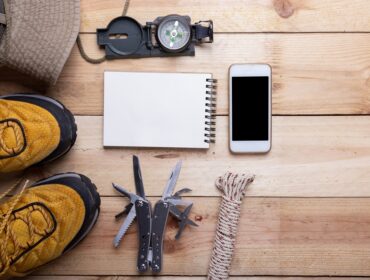It’s time to start using your compass with confidence. Navigation and orientation are essential wilderness skills that can save your life. This is exactly why learning how to use a compass is so important. Plus, it requires no modern powering, works with any map, and barely weighs anything. Just because we have a GPS in our phones doesn’t mean it will always work when we need it most. However, learning how to use one can be intimidating but with some practice and this article, you’ll become a pro in no time.

Types of Compasses
The chances are your compass identifies with one of the three styles:
- Baseplate Compass – The most typical type of compasses are a great introduction to learning navigational skills. This style typically weighs very little and is perfect from hiking to backpacking.
- Mirrored Baseplate Compass (Sighting Compass) – This type offers more advanced sighting capabilities and often includes more advanced features that can measure heights or slope angle.
- Lensatic Compass – Lensatic compasses are based on a classic U.S. military compass and are trusted among military and paramilitary personnel.
They all have the same core function — navigation and orientation. Arguably one of the greatest inventions, the compass has changed the course of history and human potential. The compass dates back to between the second century BC and first century AD China, during the Han Dynasty. In modern day, even with all the technology we have and will have, learning to read your compass could save your life.

Parts of a Compass
This simple yet powerful instrument has a few key parts:
Base Plate with Scales and Rulers
This is the clear flat surface that makes your compass easy to hold, find, and use. This plate is always made of a transparent material so you can clearly see your map under the compass.
Orienteering Arrow
This is where you will line up the red side of the magnetic arrow to find true north. These markings will look different from compass to compass. Regardless of how they look, people call this “red in the shed.” This is an easy way to remember how to find north.
Compass Dial
This is a ring that reads clockwise with degrees 0 to 360 etched on the outer edges. Sometimes called “the heart of the compass,” the compass dial will be filled with air or liquid.
Index line
This is a small notch on top of your compass dial that will help you read your bearings.
Orienting Lines
This is a series of parallel lines located under the compass dial. These lines are used to help you find north and south when aligning your compass to a map.
Magnetic Arrow
Located within the compass dial, the magnetic piece of medal serves as our arrow. The red end always points north and the white end will always point south. This magnetic element responds to the earth’s natural magnetic field, which naturally moves the arrow to help us navigate correctly.
Direction of Travel Arrow
This is located on the base plate as a fixed arrow that points to the way you will be traveling after a bearing is set. You will want to point this toward where you’re aiming to travel while using your compass.
Declination Scale
Magnetic declination is the angle on the horizontal plane between magnetic north and true north. This angle read in degrees will vary depending on where you are in the country. This will change over time as the earth changes.
With more advanced and expensive compasses, there may be more bells and whistles. Although, these are the parts of a basic compass. With all the parts and functions in mind, let’s move on to how to adjust your compass for successful navigation
How to Adjust Your Compass
Now that you’re familiar with your compass, let’s talk about adjusting it to our location. There’s a few ways to orient your location. First, you’ll need to set your dedication scale with a map.
To accurately adjust your compass, you’ll need to find declination between magnetic north — where your compass will point — and actual north. This step is a surprising yet essential part of accurate navigation because a single degree of error can set you off course by up to a mile.
You have to find the declination value in your trip area before you can start to adjust your compass. Many maps will list the value in degrees near the legend of the key. However, if the map is older, it’s best to check resources like the National Oceanic and Atmospheric Administration (NOAA) magnetic declination or other websites dedicated to tracking the shift in declination as it shifts.
Always make sure you find the declination value before you leave for your trip.
Once you know the declination value for your area, you can set it on your compass. The way you do this will depend on the brand of your compass. It’s best practice to learn how to set your declination on the compass you plan to bring before you take it on an adventure. Once you set it, you can line up your orienting arrow with the red side of your magnetic arrow i.e. ‘Red in the shed’ to find true north in your area.

How to Read Your Compass
When it comes to reading your compass to get from Point A to Point B, it will depend on what kind of accuracy you want along with the information and tools you have. If you don’t have a map and know you need to head in a certain direction, you can use your compass with your declination set to put you in the right direction.
If you’re looking for more accuracy and have a map, there’s a few more steps. First, you’ll need to find your bearing. A bearing is a direction in terms of degrees. This is a more precise form of orientation and direction than just saying a cardinal direction (i.e. north, east, west, south). Once your declination is set, you can begin to find an accurate bearing.
To do this, you’ll need a map and some idea of where you are.
- Find your current location on the map by looking at your surroundings via landmarks or signage
- Set your compass so the straight edge is lined up with your location
- Find your destination on the map and slowly turn the compass toward it until you have a straight line from point a to point b. You can double check this by making sure your direction of travel arrow is facing your destination (Point B).
- Rotate your compass dial until the orienting lines match your map’s north and south
- Make sure north on your compass is aligned with north on your map (the top of the map)
- Check your index line and capture your bearing! This will be a number between 1 and 360 on your compass dial
- Hold your compass in front of you and follow that bearing to your destination
How to Make a DIY Compass
You never expect to get lost or find yourself too far off the trial. Although, if you do, you’ll want to be prepared. No matter how experienced you or someone in your group may be, it’s best to ensure your safety in every way possible. Just in case you don’t have your compass, learning how to make one with what you’ve got is vital in a survival situation.
According to sources like the National Parks Service, all you need to make a backcountry compass is:
- Sewing needle or a razor blade
- Small bar magnet or refrigerator magnet
- A small piece of cork or leaf (a flat piece from a wine bottle works, but make sure it is cork and not plastic)
- A shallow bowl or a bottle
First step is to magnetize the needle. To do this, rub your magnet along the needle (or razor blade) in one direction about 30-50 times. If you don’t have a magnet, you can use your hair, or wool and fur, to magnetize your needle.
Now that your needle is magnetized, you have two options depending on what you have and your surroundings.
Option 1
If, by chance, there’s no wind and you’re near a body of water, you can place your magnetized needle on a leaf in that body of water. You’ll see the needle pull either to the left or the right as it orients itself with the earth’s magnetism.
Option 2
This option allows you to make a portable compass. If you’re not near water, or find yourself on a gusty day, you’ll need your bottle or shallow bowl, thread or string, and your magnetized needle. Thread your needle or razor blade and secure that thread to the top of your bottle (or bowl) so that needle is dangling without interference.
No matter which backcountry compass you build, the magnetized needle should point toward the nearest magnetic pole — north or south — depending on where you are.
When you know how to read and make a compass, you can adventure into the backcountry with more confidence than ever before. Because knowing where you are in the world can really pay off.
Article by Christin Workman
Christin (she/her) is a writer and outdoor enthusiast. She’s a backpacker, hiker, ‘baby’ climber and a stop-and-smell-the-wildflowers kind of adventurer. Christin lives in Colorado with her husband, Rhodesian Ridgeback and a myriad of plants. When she’s not playing with words, she’s either out in backcountry, tending to the garden or practicing aerial arts.




